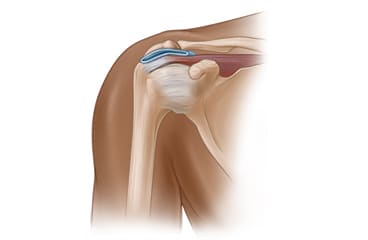Overview

Frozen shoulder is stiffness, pain, and trouble moving your shoulder. It may happen after an injury or overuse, or it may be related to a condition such as diabetes or a stroke. You may have pain that keeps you from using your shoulder. However, you need to move your shoulder. If you do not move it, it will get more stiff and sore. Your doctor may order an X-ray to make sure there is not another cause for your stiff shoulder.
You can treat frozen shoulder with heat, stretching, over-the-counter pain medicines, and physical therapy. Your doctor also may inject medicine into your shoulder to reduce pain and swelling. It can take a year or more to get better. Surgery is rarely needed.
Follow-up care is a key part of your treatment and safety. Be sure to make and go to all appointments, and call your doctor if you are having problems. It's also a good idea to know your test results and keep a list of the medicines you take.
How can you care for yourself at home?
- Take pain medicines exactly as directed.
- If the doctor gave you a prescription medicine for pain, take it as prescribed.
- If you are not taking a prescription pain medicine, ask your doctor if you can take an over-the-counter medicine.
- Put a heating pad set on low or a warm, wet towel wrapped in plastic on your shoulder. The heat may make it easier to stretch your shoulder.
- Follow your doctor's advice for stretches and exercises.
- Go to physical therapy if your doctor suggests it.
- Try these stretching exercises to reduce stiffness if your doctor says it is okay. Do the exercises slowly to avoid injury. Put a warm, wet towel on your shoulder before exercising. Stop any exercise that increases pain.
- Pendulum exercise. While leaning forward and holding onto a table or the back of a chair with your good arm, bend at the waist, allowing your affected arm to hang straight down. Swing the affected arm back and forth like a pendulum, then in circles that start small and gradually grow larger as pain allows. Try this for about 2 or 3 minutes, several times a day. Once pain begins to go away, you can do this exercise while holding a 1- or 2-pound weight.
- Wall climbing (to the side). Stand with your side to a wall so that your fingers can just touch it. Then turn so your body is turned slightly toward the wall. Walk the fingers of your injured arm up the wall as high as pain permits. Hold that position for a count of 15 to 30 seconds. Walk your fingers down to the starting position. Repeat 2 to 4 times, trying to reach higher each time.
- Wall climbing (to the front). Face a wall, standing so your fingers can just touch it. Walk the fingers of your affected arm up the wall as high as pain permits. Hold that position for a count of 15 to 30 seconds. Slowly walk your fingers to the starting position. Repeat 2 to 4 times, trying to reach higher each time.
Call your doctor now or seek immediate medical care if:
- You have severe pain.
- Your arm is cool or pale or changes color.
- You have tingling or numbness in your arm.
Watch closely for changes in your health, and be sure to contact your doctor if:
- You have increased pain.
- You have new pain that develops in another area. For example, you have pain in your arm, hand, or elbow.
- You do not get better as expected.
Where can you learn more?
Go to http://www.healthwise.net/patientEd
Enter E636 in the search box to learn more about "Frozen Shoulder: Care Instructions".
Current as of: July 24, 2025
Author: Ignite Healthwise, LLC Staff
Clinical Review Board
All Ignite Healthwise, LLC education is reviewed by a team that includes physicians, nurses, advanced practitioners, registered dieticians, and other healthcare professionals.

